When adapting recipes between dried and fresh basil, the 1:3 ratio serves as your foundational guideline. This conversion factor exists because the drying process removes approximately 90% of the herb's water content, concentrating its flavor compounds. Dried basil typically contains three times the flavor intensity of its fresh counterpart, making proper measurement critical for culinary success.
Understanding Basil Potency Differences
The science behind dry basil to fresh conversion lies in the dehydration process. Fresh basil consists of about 92% water, while dried basil contains only 5-10% moisture. As water evaporates, the volatile oils responsible for basil's distinctive flavor become more concentrated. This explains why a small amount of dried basil can match the flavor impact of a larger quantity of fresh.
However, the conversion isn't merely mathematical. Dried basil develops different flavor compounds during dehydration, resulting in a more muted, earthy profile compared to fresh basil's bright, sweet notes with hints of anise. When converting dried basil to fresh in recipes, consider both the measurement adjustment and these flavor profile differences.
Practical Conversion Chart
| Dried Basil | Fresh Basil Equivalent | Common Recipe Application |
|---|---|---|
| ¼ teaspoon | ¾ teaspoon, chopped | Small batch dressings, sauces |
| ½ teaspoon | 1½ teaspoons, chopped | Individual portions, small dishes |
| 1 teaspoon | 1 tablespoon, chopped | Standard recipe conversion |
| 1 tablespoon | 3 tablespoons (¼ cup), chopped | Larger recipes, soups, stews |
| 2 tablespoons | 6 tablespoons (½ cup), chopped | Family-sized dishes, casseroles |
Factors Affecting Dry Basil to Fresh Conversion Accuracy
Several variables influence the precision of your dried basil to fresh basil substitution:
Herb Quality and Age
Freshness matters significantly in dry basil to fresh conversion. Dried basil loses potency over time—properly stored in a cool, dark place, it maintains optimal flavor for 6-12 months. Older dried basil may require slightly increased measurements to achieve equivalent flavor. Conversely, fresh basil that's nearing spoilage won't deliver its full flavor potential, potentially requiring additional amounts.
Recipe Type Considerations
The cooking method affects your dry basil to fresh conversion approach:
- Long-simmered dishes (soups, stews, sauces): Dried basil often performs better as it has time to rehydrate and distribute flavor evenly
- Finishing applications (garnishes, pesto, caprese salad): Fresh basil provides superior texture and brighter flavor notes
- Cold preparations (dressings, salads): Fresh basil typically integrates better without the need for rehydration
Advanced Conversion Techniques
For optimal results when converting dried basil to fresh in recipes, consider these professional techniques:
Rehydration Method for Dried Basil
When substituting dried for fresh in applications requiring fresh herb texture:
- Measure the required amount of dried basil
- Place in small bowl with 2-3 times its volume of warm water or broth
- Let sit for 10-15 minutes until softened
- Drain excess liquid (reserve for cooking if desired)
- Use as you would fresh chopped basil
This technique works well for dishes like tomato salads or bruschetta where fresh herb texture matters. The rehydrated dried basil won't perfectly mimic fresh, but it provides closer texture than using dried basil directly.
Flavor Balancing Approach
Professional chefs often adjust the standard dry basil to fresh conversion ratio based on:
- Taste as you go: Add 75% of the converted amount initially, then adjust
- Acid balance: Fresh basil's brighter notes may require slight acid reduction
- Timing of addition: Add fresh basil later in cooking to preserve volatile compounds
Common Conversion Mistakes to Avoid
Many home cooks make these errors when converting dried basil to fresh:
- Using equal measurements: Treating dried and fresh basil as interchangeable without conversion
- Overcompensating: Adding too much fresh basil when substituting for dried, creating overpowering flavor
- Ignoring recipe timing: Adding fresh basil too early in cooking, causing flavor degradation
- Improper storage: Keeping dried basil in humid conditions, reducing potency and throwing off conversions
When Substitution Isn't Recommended
While dry basil to fresh conversion works for most applications, certain dishes benefit from using the specified form:
- Pesto: Fresh basil is essential for proper texture and bright flavor
- Caprese salad: Fresh basil provides necessary visual appeal and texture
- Long-cooked tomato sauces: Dried basil often integrates better flavor-wise
- Infused oils: Fresh basil can introduce moisture leading to spoilage risks
Understanding these nuances ensures your dry basil to fresh conversion maintains both flavor integrity and food safety standards in your cooking.
Maximizing Flavor in Conversions
To get the most from your dried basil to fresh basil substitution:
- Crush dried basil between your fingers before adding to release essential oils
- Add fresh basil during the last 5-10 minutes of cooking to preserve volatile compounds
- Store dried basil in airtight containers away from light and heat to maintain consistent potency
- Consider leaf size when chopping fresh basil—larger leaves yield more volume per weight
By understanding these dry basil to fresh conversion principles, you'll consistently achieve balanced flavors regardless of which form you have available. Remember that cooking is both science and art—while the 1:3 ratio provides a reliable starting point, always trust your palate for final seasoning adjustments.











 浙公网安备
33010002000092号
浙公网安备
33010002000092号 浙B2-20120091-4
浙B2-20120091-4